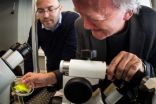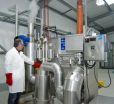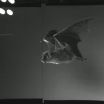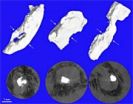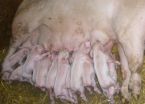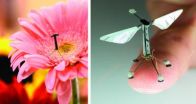(Press-News.org) CAMBRIDGE, Mass-- Graphene's promise as a material for new kinds of electronic devices, among other uses, has led researchers around the world to study the material in search of new applications. But one of the biggest limitations to wider use of the strong, lightweight, highly conductive material has been the hurdle of fabrication on an industrial scale.
Initial work with the carbon material, which forms an atomic-scale mesh and is just a single atom thick, has relied on the use of tiny flakes, typically obtained by quickly removing a piece of sticky tape from a block of graphite — a low-tech system that does not lend itself to manufacturing. Since then, focus has shifted to making graphene films on metal foil, but researchers have faced difficulties in transferring the graphene from the foil to useful substrates.
Now researchers at MIT and the University of Michigan have come up with a way of producing graphene, in a process that lends itself to scaling up, by making graphene directly on materials such as large sheets of glass. The process is described, in a paper published this week in the journal Scientific Reports, by a team of nine researchers led by A. John Hart of MIT. Lead authors of the paper are Dan McNerny, a former MIT postdoc who is now at Michigan, and Viswanath Balakrishnan, a former MIT postdoc who is now at the Indian Institute of Technology.
Currently, most methods of making graphene first grow the material on a film of metal, such as nickel or copper, says Hart, the Mitsui Career Development Associate Professor of Mechanical Engineering. "To make it useful, you have to get it off the metal and onto a substrate, such as a silicon wafer or a polymer sheet, or something larger like a sheet of glass," he says. "But the process of transferring it has become much more frustrating than the process of growing the graphene itself, and can damage and contaminate the graphene."
The new work, Hart says, still uses a metal film as the template — but instead of making graphene only on top of the metal film, it makes graphene on both the film's top and bottom. The substrate in this case is silicon dioxide, a form of glass, with a film of nickel on top of it.
Using chemical vapor deposition (CVD) to deposit a graphene layer on top of the nickel film, Hart says, yields "not only graphene on top [of the nickel layer], but also on the bottom." The nickel film can then be peeled away, leaving just the graphene on top of the nonmetallic substrate.
This way, there's no need for a separate process to attach the graphene to the intended substrate — whether it's a large plate of glass for a display screen, or a thin, flexible material that could be used as the basis for a lightweight, portable solar cell, for example. "You do the CVD on the substrate, and, using our method, the graphene stays behind on the substrate," Hart says.
In addition to the researchers at Michigan, where Hart previously taught, the work was done in collaboration with a large glass manufacturer, Guardian Industries. "To meet their manufacturing needs, it must be very scalable," Hart says. The company currently uses a float process, where glass moves along at a speed of several meters per minute in facilities that produce hundreds of tons of glass every day. "We were inspired by the need to develop a scalable manufacturing process that could produce graphene directly on a glass substrate," Hart says.
The work is still in an early stage; Hart cautions that "we still need to improve the uniformity and the quality of the graphene to make it useful." But the potential is great, he suggests: "The ability to produce graphene directly on nonmetal substrates could be used for large-format displays and touch screens, and for 'smart' windows that have integrated devices like heaters and sensors."
Hart adds that the approach could also be used for small-scale applications, such as integrated circuits on silicon wafers, if graphene can be synthesized at lower temperatures than were used in the present study.
"This new process is based on an understanding of graphene growth in concert with the mechanics of the nickel film," he says. "We've shown this mechanism can work. Now it's a matter of improving the attributes needed to produce a high-performance graphene coating."
INFORMATION:
The work was supported by Guardian Industries, the National Science Foundation, and the Air Force Office of Scientific Research.
Written by David Chandler, MIT News Office
A new way to make sheets of graphene
Technique might enable advances in display screens, solar cells, or other devices
2014-05-23
ELSE PRESS RELEASES FROM THIS DATE:
Breakthrough method for making Janus or patchy capsules
2014-05-23
Hollow capsules that have a selectively permeable shell are promising candidates as tiny containers for molecules, particles or bubbles, and are becoming increasingly important in a wide variety of applications. But making these kinds of capsules with more than one kind of substance on their shells has been challenging – until now.
In a article in the latest edition of Nature Communications, NTNU researcher Jon Otto Fossum and Paul Dommersnes from the University of Paris, Diderot, were part of a team that showed that both Janus and more advanced patchy capsules can ...
Straw from oilseed as a new source of biofuels
2014-05-23
The bright yellow fields of oilseed rape are a familiar sight at this time of year, but for scientists what lies beneath is just as exciting.
Researchers at the Institute of Food Research are looking at how to turn straw from oilseed rape into biofuel. Preliminary findings are pointing at ways the process could be made more efficient, as well as how the straw itself could be improved.
Straw from crops such as wheat, barley, oats and oilseed rape is seen as a potential source of biomass for second generation biofuel production. Currently the UK produces around 12 million ...
Tiny muscles help bats fine-tune flight, stiffen wing skin
2014-05-23
VIDEO:
As bats fly the air pushes their compliant skin around. A new study provides evidence that they control wing stiffness and shape using muscles embedded in their skin.
Click here for more information.
PROVIDENCE, R.I. [Brown University] — A new study of bats reveals a capability within their wondrous wings that may help them fine-tune their flight.
Bats employ a network of nearly hair-thin muscles embedded in the membrane of their inherently floppy wing skin to adjust ...
NASA sees first tropical depression of Eastern Pacific hurricane season
2014-05-23
One week after the official start of hurricane season in the Eastern Pacific Ocean, the first tropical depression was born hundreds of miles southwest of Mexico. NASA's TRMM satellite and NOAA's GOES-West satellites provided looks inside and outside of the depression's clouds. Hurricane season in the Eastern Pacific began officially on May 15.
On May 21 at 22:59 UTC (6:59 p.m. EDT) the Tropical Rainfall Measuring Mission (TRMM) satellite passed over System 92E, which was what Tropical Depression 1E (TD1E) was called before it organized into a depression. TRMM's Precipitation ...
Supernova caught in the act by palomar transient factory
2014-05-23
Supernovae—stellar explosions—are incredibly energetic, dynamic events. It is easy to imagine that they are uncommon, but the universe is a big place and supernovae are actually fairly routine. The problem with observing supernovae is knowing just when and where one is occurring and being able to point a world-class telescope at it in the hours immediately afterward, when precious data about the supernova's progenitor star is available. Fortunately the intermediate Palomar Transient Factory (iPTF) operated by Caltech scans the sky constantly in search of dramatic astrophysical ...
Mapping atherosclerotic arteries: Combined approach developed
2014-05-23
A new method allows calcified and constricted blood vessels to be visualized with micrometer precision, and can be used to design containers for targeted drug delivery. Within the project "NO-stress", materials scientists from the Medical Faculty of the University of Basel combined cutting-edge-imaging techniques to visualize and quantify the constrictions caused by atherosclerosis.
Cardiovascular diseases, including atherosclerosis, are associated with plaque formation and the most prevalent cause of death worldwide. Unlike vessels and other soft tissues, the plaque ...
Risk is much more than a game
2014-05-23
Wildfires and flooding affect many more people in the USA than earthquakes and landslide and yet the dread, the perceived risk, of the latter two is much greater than for those hazards that are more frequent and cause greater loss of life. Research published in the International Journal of Risk Assessment and Management, suggests that a new paradigm for risk assessment is needed so that mitigation plans in the face of natural disasters can be framed appropriately by policy makers and those in the emergency services.
Maura Knutson (nee Hurley) and Ross Corotis of the University ...
The protective milk shot
2014-05-23
Antibodies against C. suis are transferred via the sow's very first milk to the piglets immediately after birth. This was discovered by veterinarian and parasitologist Lukas Schwarz and his colleagues in 2013. These findings prompted the researchers at the Institute for Parasitology to look for a way to increase the level of these antibodies in sows. The ultimate goal was to provide the piglets with as much antibodies as possible via their mother's milk during the first few days of life.
Piglets from infected mothers are healthier
The idea paid off. Piglets from infected ...
Nature inspires drones of the future
2014-05-23
Researchers have been taking tips from nature to build the next generation of flying robots.
Based on the mechanisms adopted by birds, bats, insects and snakes, 14 distinguished research teams have developed solutions to some of the common problems that drones could be faced with when navigating through an urban environment and performing novel tasks for the benefit of society.
Whether this is avoiding obstacles, picking up and delivering items or improving the take-off and landing on tricky surfaces, it is hoped the solutions can lead to the deployment of drones in ...
Rapid evolution aids spread of exotic plant species
2014-05-23
A team of Belgian biologists led by researchers at KU Leuven has provided the first genetic evidence that rapid evolution can help non-native plant species spread in new environments. Using samples of centuries-old herbaria and DNA analysis, the researchers reconstructed the genetic adaptations undergone by the Pyrenean rocket prior to its rapid spread in Belgium.
The Pyrenean rocket (Sisymbrium austriacum subsp. chrysanthum) is a plant that grows in the mountains of southern Europe and is particularly prevalent in the Pyrenees. The species was first reported in Belgium ...
LAST 30 PRESS RELEASES:
Air pollution exposure and birth weight
Obstructive sleep apnea risk and mental health conditions among older adults
How talking slows eye movements behind the wheel
The Ceramic Society of Japan’s Oxoate Ceramics Research Association launches new international book project
Heart-brain connection: international study reveals the role of the vagus nerve in keeping the heart young
Researchers identify Rb1 as a predictive biomarker for a new therapeutic strategy in some breast cancers
Survey reveals ethical gaps slowing AI adoption in pediatric surgery
Stimulant ADHD medications work differently than thought
AI overestimates how smart people are, according to HSE economists
HSE researchers create genome-wide map of quadruplexes
Scientists boost cell "powerhouses" to burn more calories
Automatic label checking: The missing step in making reliable medical AI
Low daily alcohol intake linked to 50% heightened mouth cancer risk in India
American Meteorological Society announces Rick Spinrad as 2026 President-Elect
Biomass-based carbon capture spotlighted in newly released global climate webinar recording
Illuminating invisible nano pollutants: advanced bioimaging tracks the full journey of emerging nanoscale contaminants in living systems
How does age affect recovery from spinal cord injury?
Novel AI tool offers prognosis for patients with head and neck cancer
Fathers’ microplastic exposure tied to their children’s metabolic problems
Research validates laboratory model for studying high-grade serous ovarian cancer
SIR 2026 delivers transformative breakthroughs in minimally invasive medicine to improve patient care
Stem Cell Reports most downloaded papers of 2025 highlight the breadth and impact of stem cell research
Oxford-led study estimates NHS spends around 3% of its primary and secondary care budget on the health impacts of heat and cold in England
A researcher’s long quest leads to a smart composite breakthrough
Urban wild bees act as “microbial sensors” of city health.
New study finds where you live affects recovery after a hip fracture
Forecasting the impact of fully automated vehicle adoption on US road traffic injuries
Alcohol-related hospitalizations from 2016 to 2022
Semaglutide and hospitalizations in patients with obesity and established cardiovascular disease
Researchers ‘listen in’ to embryo-mother interactions during implantation using a culture system replicating the womb lining
[Press-News.org] A new way to make sheets of grapheneTechnique might enable advances in display screens, solar cells, or other devices
